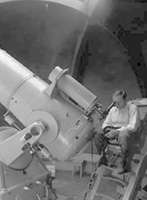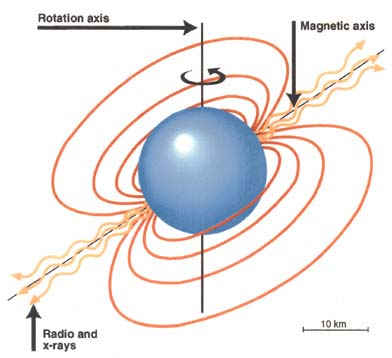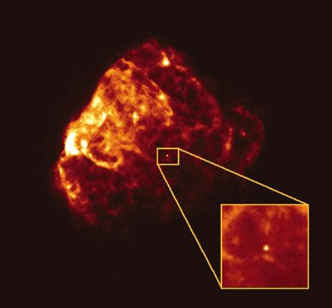

Chadwick's 1932 discovery of the neutron led to immediate speculation that entire stars made up of such particles might exist. An astrophysically motivated (and as it turned out visionary) view was taken by Fritz Zwicky. He suggested that neutron stars might be the remnants of supernovae.
 |
With all reserve we advance the view that a supernova represents the transition of an ordinary star into a neutron star, consisting mainly of neutrons. Such a star may possess a very small radius and an extremely high density ... A neutron star would ... represent the most stable configuration of matter as such. [Baade (left) and Zwicky (right) 1934] |  |
In the 1930s there were, of course, no observational evidence that supported this suggestion. So even though the association between supernovae and neutron stars would be established some forty years later, Zwicky would for a long time remain the sole advocate of this idea. Conventional astronomy basically had no need for anything more exotic than white dwarfs as endproduct of stellar evolution.

In 1967 two Cambridge radio astronomers, Anthony Hewish and Jocelyn Bell, found a surprising periodic signal in the data from their new telescope. The signal, that looked suspiciosly manmade, consisted of a series of equally spaced pulses 3.7 seconds apart. Hewitt and Bell racked their brains for an explanation. The source was far too fast to be something like a pulsating star, and it could not be earthbound because it kept sidereal time. Many possibilities were discarded, including the suggestion that the signal came from a distant civilization! Although they did not really believe in that possibility, Hewitt and Bell had to take it seriously. That they did so is illustrated by the fact that the first four of these periodic sources were initially listed as LGM 1-4 (Little Green Men). Once several such objects were found the explanation of other civilizations seeking contact did, of course, become unreasonable. The paper detailing the discovery soon appeared in Nature, and Anthony Hewish was awarded the Nobel Prize for the discovery of this new class of stars, the pulsars, in 1974.
| Soon after the discovery of pulsars Thomas Gold suggested that they were, in fact, rotating neutron stars. We see pulses because the beam pattern is misaligned with the rotation axis of a neutron star with a strong magnetic field. As the star spins the pulsar beam sweeps across the sky, and once every revolution it can be picked up by telescopes on Earth. |  |
This spinning neutron star model predicted that pulsars should spin down at a certain rate, a behaviour that was subsequently observed. Specifically, in 1968 radio observations at Arecibo showed that the spindown rate of the Crab pulsar agreed with the energy measured to be radiated (in X-rays) by the surrounding nebula. Thus, the model of pulsars being rapidly spinning neutron stars was confirmed.
These observations verified the association between neutron stars and supernova remnants that had been anticipated by Fritz Zwicky thirty years earlier. Today we know that the Crab pulsar, that has a spin period on 33 ms, was born in the supernova that was observed by Chinese astronomers in 1054. Since the early days more than a thousand pulsars have been observed. The range of observed rotation periods is enormous, ranging from the 1.56 ms of PSR 1937+21 to several seconds for the slowest pulsars. But even though we have a wealth of observations, the neutron stars still hide many of their secrets.
 |
A neutron star is hard to detect directly because it is small and therefore dim, but newly formed it is hot and glowing in X-rays. The X-ray images to the left was taken by ROSAT, and offers a premier view of a young neutron star in the supernova remnant Puppis A.
|